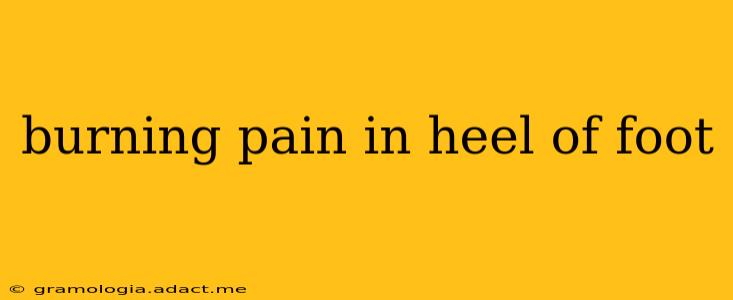Experiencing a burning pain in the heel of your foot can be incredibly debilitating, impacting your daily activities and overall quality of life. This sharp, intense discomfort can range from a mild, intermittent ache to a persistent, searing sensation, making even simple tasks like walking incredibly challenging. Understanding the potential causes, effective diagnostic methods, and available treatments is crucial for finding relief. This comprehensive guide will explore the various reasons behind heel pain, helping you navigate your path to recovery.
What Causes Burning Pain in the Heel of My Foot?
Several conditions can contribute to burning heel pain. Pinpointing the exact cause requires a thorough evaluation by a healthcare professional. However, some of the most common culprits include:
-
Plantar fasciitis: This is arguably the most prevalent cause of heel pain. It involves inflammation of the plantar fascia, a thick band of tissue running along the bottom of your foot, connecting your heel bone to your toes. The burning sensation often accompanies the more familiar sharp heel pain.
-
Heel spur: A bony growth (spur) on the heel bone can irritate the plantar fascia, leading to inflammation and burning pain. Often, heel spurs are asymptomatic, only causing problems when they contribute to plantar fasciitis or other conditions.
-
Nerve irritation: Conditions like tarsal tunnel syndrome (compression of the tibial nerve behind the ankle) or other nerve entrapments can result in burning, tingling, and pain in the heel.
-
Achilles tendinitis: Inflammation of the Achilles tendon, which connects your calf muscles to your heel bone, can cause pain radiating into the heel, sometimes described as burning.
-
Stress fractures: Tiny cracks in the heel bone, often caused by overuse or repetitive impact, can lead to burning pain, especially during activity.
-
Bursitis: Inflammation of the bursae (fluid-filled sacs that cushion the heel bone) can cause localized burning pain.
-
Peripheral neuropathy: This condition, often associated with diabetes or other systemic diseases, involves nerve damage that can manifest as burning or tingling pain in the feet and heels.
What are the symptoms of burning heel pain?
Burning heel pain is characterized by a burning or searing sensation in the heel, often accompanied by other symptoms depending on the underlying cause. These can include:
- Sharp pain: Especially when you first step out of bed or after periods of rest.
- Throbbing pain: A persistent, pulsating ache in the heel area.
- Tingling or numbness: In the heel or surrounding areas, often indicative of nerve involvement.
- Stiffness: Difficulty bending the foot or ankle.
- Swelling: Visible swelling in the heel or ankle area.
- Redness or discoloration: Changes in the skin color around the heel.
How is burning heel pain diagnosed?
Your doctor will likely conduct a physical exam to assess your symptoms and range of motion. They'll ask about your medical history, activities, and the onset of the pain. Imaging tests, such as X-rays, may be ordered to rule out fractures or bone spurs. In some cases, an ultrasound or MRI might be necessary to evaluate soft tissues and nerves. A thorough neurological examination may be performed to assess nerve function, especially if nerve irritation is suspected.
What are the treatment options for burning heel pain?
Treatment strategies depend on the underlying cause and the severity of the pain. Options often include:
-
Rest and ice: Avoiding activities that aggravate the pain and applying ice packs can reduce inflammation.
-
Over-the-counter pain relievers: Ibuprofen or naproxen can help manage pain and inflammation.
-
Orthotics: Custom-made or over-the-counter arch supports can help alleviate pressure on the plantar fascia.
-
Physical therapy: Stretching and strengthening exercises can improve flexibility and support the heel.
-
Injections: Corticosteroid injections can reduce inflammation in cases of plantar fasciitis or bursitis.
-
Night splints: These devices gently stretch the plantar fascia while you sleep.
-
Surgery: In rare cases, surgery might be considered to address severe heel spurs or other underlying conditions.
How can I prevent burning heel pain?
Preventing heel pain often involves proactive measures to support foot health:
-
Maintaining a healthy weight: Excess weight puts added stress on your feet and heels.
-
Wearing supportive footwear: Choose shoes with good arch support and cushioning.
-
Stretching regularly: Regular stretching of the calf muscles and plantar fascia can prevent tightness and inflammation.
-
Avoiding prolonged standing or walking: Take breaks and elevate your feet when possible.
-
Using proper running technique: If you're a runner, ensure your running form is correct to reduce stress on your heels.
Is burning heel pain always plantar fasciitis?
No, burning heel pain is not always plantar fasciitis. While plantar fasciitis is a common cause, several other conditions can also lead to this symptom. Accurate diagnosis is crucial for effective treatment.
What if my burning heel pain doesn't improve with home remedies?
If home remedies don't provide relief after a few weeks, it's essential to consult a podiatrist or other healthcare professional. They can perform a proper evaluation, diagnose the underlying cause, and recommend appropriate treatment options.
When should I see a doctor for burning heel pain?
Seek medical attention if your heel pain is severe, persistent, accompanied by other concerning symptoms (like numbness or swelling), or doesn't improve with home care. Prompt diagnosis and treatment can prevent the condition from becoming chronic.
This information is for general knowledge and does not constitute medical advice. Always consult with a healthcare professional for diagnosis and treatment of any medical condition.
